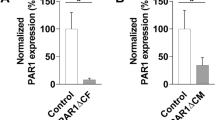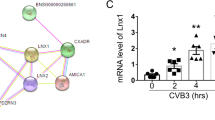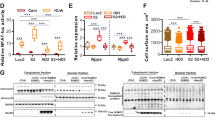Abstract
Viral myocarditis (VMC) is a cardiac disease associated with myocardial inflammation and injury induced by virus infection. Cardiomyocytes have recently been regarded as key players in eliciting and modulating inflammation within the myocardium. Kruppel-like factor 10 (KLF10) is a crucial regulator of various pathological processes and plays different roles in a variety of diseases. However, its role in VMC induced by coxsackievirus B3 (CVB3) infection remains unknown. In this study, we report that cardiac KLF10 confers enhanced protection against viral myocarditis. We found that KLF10 expression was downregulated upon CVB3 infection. KLF10 deficiency enhanced cardiac viral replication and aggravated VMC progress. Bone marrow chimera experiments indicated that KLF10 expression in nonhematopoietic cells was involved in the pathogenesis of VMC. We further identified MCP-1 as a novel target of KLF10 in cardiomyocytes, and KLF10 cooperated with histone deacetylase 1 (HDAC1) to negatively regulate MCP-1 expression by binding its promoter, leading to activation of MCP-1 transcription and recruitment of Ly6Chigh monocytes/macrophages into the myocardium. This novel mechanism of MCP-1 regulation by KLF10 might provide new insights into the pathogenesis of VMC and a potential therapeutic target for VMC.
This is a preview of subscription content, access via your institution
Access options
Subscribe to this journal
Receive 12 digital issues and online access to articles
$119.00 per year
only $9.92 per issue
Buy this article
- Purchase on Springer Link
- Instant access to full article PDF
Prices may be subject to local taxes which are calculated during checkout









Similar content being viewed by others
References
Liu, P. P. & Mason, J. W. Advances in the understanding of myocarditis. Circulation 104, 1076–1082 (2001).
Pollack, A., Kontorovich, A. R., Fuster, V. & Dec, G. W. Viral myocarditis-diagnosis, treatment options, and current controversies. Nat. Rev. Cardiol. 12, 670–680 (2015).
Schultz, J. C., Hilliard, A. A., Cooper, L. T. Jr. & Rihal, C. S. Diagnosis and treatment of viral myocarditis. Mayo Clin. Proc. 84, 1001–1009 (2009).
Bacmeister, L. et al. Inflammation and fibrosis in murine models of heart failure. Basic Res. Cardiol. 114, 19 (2019).
Tam, P. E. Coxsackievirus myocarditis: interplay between virus and host in the pathogenesis of heart disease. Viral Immunol. 19, 133–146 (2006).
Yajima, T. & Knowlton, K. U. Viral myocarditis: from the perspective of the virus. Circulation 119, 2615–2624 (2009).
Esfandiarei, M. & McManus, B. M. Molecular biology and pathogenesis of viral myocarditis. Annu Rev. Pathol. 3, 127–155 (2008).
Ghigo, A., Franco, I., Morello, F. & Hirsch, E. Myocyte signalling in leucocyte recruitment to the heart. Cardiovasc, Res. 102, 270–280 (2014).
Wrigley, B. J., Lip, G. Y. & Shantsila, E. The role of monocytes and inflammation in the pathophysiology of heart failure. Eur. J. Heart Fail 13, 1161–1171 (2011).
Aoyagi, T. & Matsui, T. The cardiomyocyte as a source of cytokines in cardiac injury. J.Cell Sci. Ther. 2012, 003 (2011).
Kai, H., Kuwahara, F., Tokuda, K. & Imaizumi, T. Diastolic dysfunction in hypertensive hearts: roles of perivascular inflammation and reactive myocardial fibrosis. Hypertens. Res. 28, 483–490 (2005).
McCarthy, C. G. et al. Toll-like receptors and damage-associated molecular patterns: novel links between inflammation and hypertension. Am. J. Physiol. Heart Circ. Physiol. 306, H184–H196 (2014).
Shen, Y. et al. Coxsackievirus group B type 3 infection upregulates expression of monocyte chemoattractant protein 1 in cardiac myocytes, which leads to enhanced migration of mononuclear cells in viral myocarditis. J. Virol. 78, 12548–12556 (2004).
Niu, J. & Kolattukudy, P. E. Role of MCP-1 in cardiovascular disease: molecular mechanisms and clinical implications. Clin. Sci. 117, 95–109 (2009).
Leuschner, F. et al. Silencing of CCR2 in myocarditis. Eur. Heart J. 36, 1478–1488 (2015).
Yue, Y., Gui, J., Xu, W. & Xiong, S. Gene therapy with CCL2 (MCP-1) mutant protects CVB3-induced myocarditis by compromising Th1 polarization. Mol. Immunol. 48, 706–713 (2011).
Black, A. R., Black, J. D. & Azizkhan-Clifford, J. Sp1 and kruppel-like factor family of transcription factors in cell growth regulation and cancer. J. Cell Physiol. 188, 143–160 (2001).
Cao, Z., Sun, X., Icli, B., Wara, A. K. & Feinberg, M. W. Role of Kruppel-like factors in leukocyte development, function, and disease. Blood 116, 4404–4414 (2010).
Feinberg, M. W. et al. The Kruppel-like factor KLF4 is a critical regulator of monocyte differentiation. EMBO J. 26, 4138–4148 (2007).
Subramaniam, M. et al. TIEG1 null mouse-derived osteoblasts are defective in mineralization and in support of osteoclast differentiation in vitro. Mol. Cell Biol. 25, 1191–1199 (2005).
Subramaniam, M. et al. Identification of a novel TGF-beta-regulated gene encoding a putative zinc finger protein in human osteoblasts. Nucleic Acids Res. 23, 4907–4912 (1995).
Zhang, W. et al. Klf10 inhibits IL-12p40 production in macrophage colony-stimulating factor-induced mouse bone marrow-derived macrophages. Eur. J. Immunol. 43, 258–269 (2013).
Rajamannan, N. M. et al. TGFbeta inducible early gene-1 (TIEG1) and cardiac hypertrophy: Discovery and characterization of a novel signaling pathway. J. Cell Biochem. 100, 315–325 (2007).
Cen, M. et al. TIEG1 deficiency confers enhanced myocardial protection in the infarcted heart by mediating the Pten/Akt signalling pathway. Int J. Mol. Med. 39, 569–578 (2017).
Li, M. et al. MCPIP1 inhibits coxsackievirus B3 replication by targeting viral RNA and negatively regulates virus-induced inflammation. Med. Microbiol. Immunol. 207, 27–38 (2018).
Liu, Y. et al. Kruppel-like factor 10 (KLF10) is transactivated by the transcription factor C/EBPbeta and involved in early 3T3-L1 preadipocyte differentiation. J. Biol. Chem. 293, 14012–14021 (2018).
Elsharkawy, A. M. et al. The NF-kappaB p50:p50:HDAC-1 repressor complex orchestrates transcriptional inhibition of multiple pro-inflammatory genes. J. Hepatol. 53, 519–527 (2010).
Subramaniam, M., Hawse, J. R., Rajamannan, N. M., Ingle, J. N. & Spelsberg, T. C. Functional role of KLF10 in multiple disease processes. Biofactors 36, 8–18 (2010).
Esfandiarei, M. et al. Coxsackievirus B3 activates nuclear factor kappa B transcription factor via a phosphatidylinositol-3 kinase/protein kinase B-dependent pathway to improve host cell viability. Cell Microbiol. 9, 2358–2371 (2007).
Garmaroudi, F. S. et al. Coxsackievirus B3 replication and pathogenesis. Future Microbiol. 10, 629–653 (2015).
Wu, L. et al. Cardiac fibroblasts mediate IL-17A-driven inflammatory dilated cardiomyopathy. J. Exp. Med. 211, 1449–1464 (2014).
Acknowledgements
This work was supported by the Chinese National Natural Science Foundation (31400769, 31870903, 31870868, and 31670930), Jiangsu Province Natural Science Foundation (BK20140371) and Jiangsu Postdoctoral Science Foundation (1402176C), Priority Academic Program Development of Jiangsu Higher Education Institutions.
Author information
Authors and Affiliations
Contributions
M.L. designed the study, analyzed the data and wrote the manuscript. J.Y., H.K.Z., X.L.W., Y.H.S. and Y.L. performed the experiments. J.G., L.W. and Y.X.Z. revised the paper. W.X., L.W., M.S., and T.C.S. supervised the study and reviewed the paper. All authors read and approved the final version of the paper.
Corresponding authors
Ethics declarations
Competing interests
The authors declare no competing interests.
Supplementary information
Rights and permissions
About this article
Cite this article
Yang, J., Zhang, H., Wang, X. et al. Kruppel-like factor 10 protects against acute viral myocarditis by negatively regulating cardiac MCP-1 expression. Cell Mol Immunol 18, 2236–2248 (2021). https://doi.org/10.1038/s41423-020-00539-x
Received:
Revised:
Accepted:
Published:
Issue Date:
DOI: https://doi.org/10.1038/s41423-020-00539-x
Key words
This article is cited by
-
Immunopathogenesis and immunomodulatory therapy for myocarditis
Science China Life Sciences (2023)



